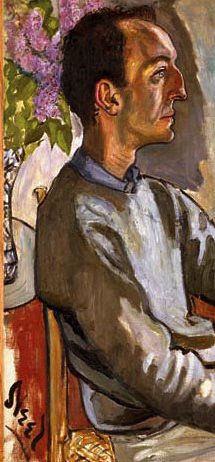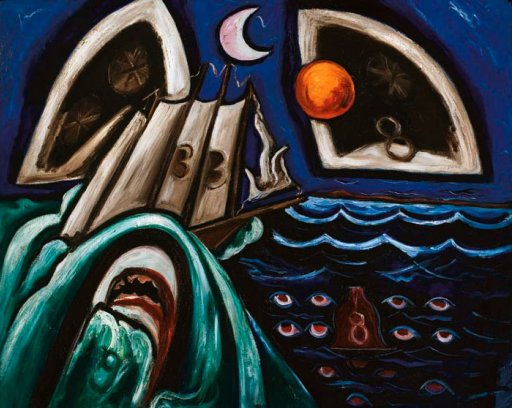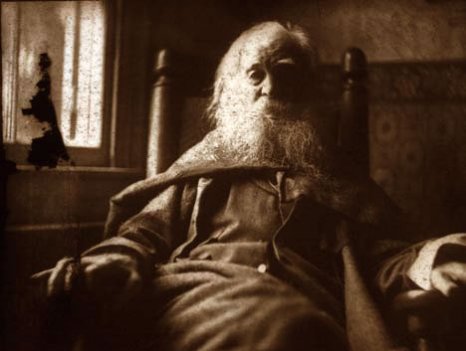 There’s a small but memorable photo in the National Portrait Gallery’s “Hide/Seek: Difference and Desire in American Portraiture,” on display until February 13, and billed as “the first major museum exhibition to focus on sexual difference in the making of modern American portraiture.” The photo, a portrait by George Platt Lynes, shows a man examining himself in a mirror with cracks that become scars across his reflected face. This thoughtful, haunting exhibit has several major themes, but this particular image, which suggests that we come to know ourselves only through others’ flawed perception of us, is perhaps the best emblem for the exhibit’s public reception.
There’s a small but memorable photo in the National Portrait Gallery’s “Hide/Seek: Difference and Desire in American Portraiture,” on display until February 13, and billed as “the first major museum exhibition to focus on sexual difference in the making of modern American portraiture.” The photo, a portrait by George Platt Lynes, shows a man examining himself in a mirror with cracks that become scars across his reflected face. This thoughtful, haunting exhibit has several major themes, but this particular image, which suggests that we come to know ourselves only through others’ flawed perception of us, is perhaps the best emblem for the exhibit’s public reception.
“Hide/Seek” aims to reshape our understanding of the American artistic canon, placing gay aesthetics at its center rather than its margins. The show opened on October 30, but managed to avoid controversy until a November 29 story on the conservative Web site CNSNews.com slammed it: “Smithsonian Christmas-Season Exhibit Features Ant-Covered Jesus, Naked Brothers Kissing, Genitalia, and Ellen DeGeneres Grabbing Her Breasts.” The case for the exhibit was not helped by the curators’ bizarre decision to organize a child-oriented “Family and Friends” event around such a sexually provocative and death-haunted show. (For the record, this event was held not in the rooms where the exhibit is shown, but in the National Portrait Gallery’s atrium.) The ensuing controversy led the museum to pull one piece from the show, David Wojnarowicz’s video “A Fire in My Belly,” better known online as the Ants on Jesus Video.
The conservative coverage of the show would lead one to expect a blasphemous saturnalia, fueled by lust and contempt; and some of the art is angry—or silly and tendentious. Yet the show is basically elegiac and introspective. Although the art is arranged chronologically, death hangs in the air long before viewers reach the art of the AIDS era. Almost half the pieces are memorials to lost lovers and friends, from Marsden Hartley’s abstract tribute to a German officer killed in World War I to Félix González-Torres’s pile of brightly-wrapped candies—as viewers take the candies, the pile dwindles like the body of the artist’s AIDS-stricken partner.

Both gay people and devoted friends—at least in the modern era, which has reduced the importance of friendship—have often been unacknowledged mourners. Their grief at the loss of a lover or friend wasn’t socially recognized, in the way the grief of spouse and family was, and so society added a cruel and specific burden of silence to the universal silence of the grave. The need to break this silence with art inspired many of the most striking works in this exhibit.
Often this mourning is expressed through abstraction and allusion. There’s the painting of a nude young man walking along a deserted city beach with his back to the tenements and spire-tipped church he’s left behind. It’s a memorial to someone who committed suicide in front of many of his friends by jumping from a window. There’s the photograph of Marsden Hartley, a year before his death, with a shadowy military officer in the background to represent both Hartley’s lost love and a beloved friend of the photographer, who had been killed in World War II. There’s also a Hartley painting commemorating Hart Crane. The controversial Wojnarowicz video is an attempt to unite the suffering of those dying of AIDS with that of Jesus on the cross, complete with the eucharistic imagery of a needle suturing a loaf of bread. In the video’s soundtrack, Diamanda Galás’s singing underlines the identification of AIDS with leprosy. She keens, “It is—unclean!” Wojnarowicz’s video is angry, yes, but it’s the kind of artwork that depends for its impact on a bone-deep response to Catholic imagery, in which suffering is not a sign of divine rejection and the Eucharist is the ultimate image of life and hope.
The paintings in this exhibit frequently refer to poetry. David Hockney swipes Whitman for “We Two Boys Together Clinging,” and Robert Rauschenberg wryly paints his own foot into an illustration for the “sodomites” canto of Dante’s Inferno, in which the sinners must run barefoot over burning sand. Among the portraits, there’s Thomas Eakins’s photo of Walt Whitman and a picture of Frank O’Hara by Larry Rivers.

The show invites us to reinterpret “American Gothic,” the Arrow Shirt Man, and many other cultural icons from the perspective of sexual minorities. Overall, this is one of the most thematically coherent exhibits I’ve seen, managing several different concepts (elegy, artistic influence, marginalization, abstraction vs. naturalism, the search for self) quite gracefully by having most of the artworks exemplify more than one of the show’s motifs. Not all of the art is of a quality equal to the show’s thematic sophistication. In any case, this is the kind of exhibit you want to discuss rather than the kind you want to wander through in sublime silence. It is an exceptionally nuanced portrayal of gay experience. To reduce it to clichéd narratives of heroes and villains—whether one’s villains are postmodern smut-peddlers or philistine Bible-thumpers—is to miss the point, as well as the beauty.
Art credits: First, Frank O’Hara, Alice Neel, 1960, National Portrait Gallery, Smithsonian Institution. Gift of Hartley S. Neel © Estate of Alice Neel. Second, Eight Bells Folly: Memorial to Hart Crane, Marsden Hartley, 1933, Frederick R. Weisman Art Museum, University of Minnesota. Gift of Ione and Hudson D. Walker. Third, Walt Whitman, Thomas Cowperthwaite Eakins, 1891 (printed 1979), National Portrait Gallery, Smithsonian Institution.

